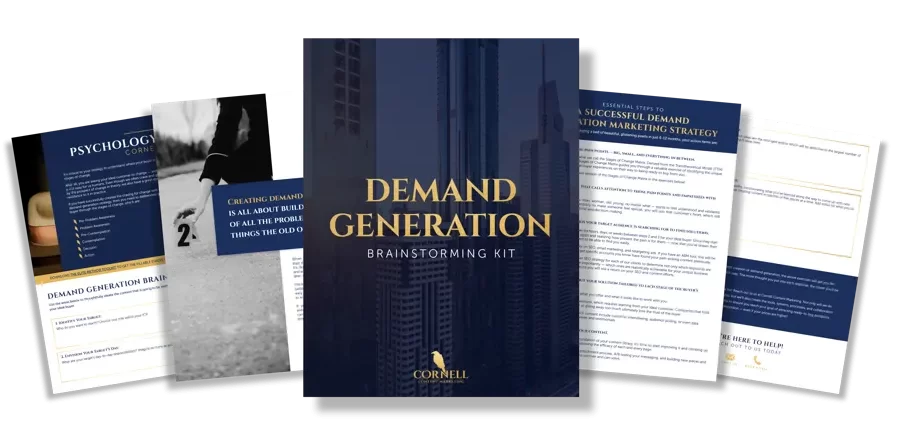Have you ever been in a situation where someone just assumes that you need what they have to sell — without ever really getting to know you, your business, or any of the things that really matter?
It’s all too familiar. A sales representative eagerly dives into a rehearsed speech about his or her company’s product, how great they are, how they’re different, claiming that they can “help” you with whatever you need… But how can they help if they don’t even know what, if anything, you are struggling with?
Companies often fail to form authentic connections with their audience when they assume that a potential customer needs their services or product without taking the time to understand their potential customer’s pain points. The result is countless missed opportunities to gain the most valuable asset in B2B marketing: customer trust.
Read on to learn the foundational marketing philosophy that will connect you with your ideal customer in a simple, straight-forward, no-BS way that builds long-term relationships and brand loyalty every single time.
Solution-First, Sale-Last Philosophy
Successfully developing long-term customer relationships hinges on understanding client needs – and doing so in a way that facilitates conversation, shows genuine compassion, and puts the customer – not the sale – first.
A few years ago, I was working with an IT consulting firm that put a heavy priority on understanding client needs. While they had five- and six-figure service packages that they were eager to sell, they knew the importance of building rapport and human connection before offering up their solutions.
This company took the time to get to know their clients, meet the key individuals who they’d be working with at the company, and understand what each person’s daily working routine was like and what they struggled with – all before making the pitch!
Because they took the time to understand their clients, they closed nearly 100% of the deals they pitched.
For B2B businesses, not only is this philosophy the only way to ensure you’re tailoring your proposal to your client’s exact needs, but also taking the time to learn your client through and through allows you to spend more time with them and forge a deeper relationship.
In B2B deals, the strongest anchor is relationship-building. So if you’re prioritizing the conversion, rushing the prospect through the process and missing critical bond-building opportunities along the way, you’re going to get passed over for a competitor who did put in the time.
Relationships Build Customer Trust
When you listen to your customers and you treat them like real people — the same way you would want to be treated! — your company can connect better, nurture better, sell better, and retain better. Jumping to any one of these goals without building those relationships first is a surefire way to waste a lot of time and money.
It’s far cheaper to retain a customer than to acquire a new one. So take the time to listen to your customers and truly understand their world, their life, and their experiences.
It’s human nature to want to stay where we feel understood, seen, and valued. When you build a relationship with your customers, you foster that rapport and deliver on those most basic, yet often overlooked, human needs.
In the world of B2B deals, it’s worth the time and effort to call up your customers and have a frank conversation. Ask them how things are going, ask them for honest feedback, and find out what you could do better to help them toward their goals — and resist the urge to have an underlying motivation of cross-selling or up-selling.
If you’re in the early stages of building your customer base or want to tap into new markets that aren’t currently represented in your existing clientele, you can use audience investigation to learn more about your ideal buyers. Here are a few simple ways to use audience investigation to tap into the language and pain points needed to build a foundation of customer trust.
Conduct Your Own Survey Research
At Cornell, we prefer PollFish, but there are several great survey tools out there that allow you to:
- Target a very specific audience so you only receive responses from relevant populations
- Automate your survey sending
- Create custom survey questions
- Test your survey questions to ensure they contain no leading language
- Automate your data collection and analytics
Once you’ve sent out your survey and collected the data, draft up a blog article, white paper, video, or podcast episode about your findings. Not only will your research provide valuable insights for your own marketing strategy, but also you’ll show your audience that you are a trustworthy primary source of information relevant to them and their peers.
Free Demand Gen Resource
Win Hearts Today, Close Deals Tomorrow
Demand generation is the most effective way to establish trust and authority with savvy B2B shoppers while attracting buyers who recognize your brand as the best on the market.
Cornell Content Marketing’s Demand Gen Brainstorming Kit sets you on the right path for building an effective and efficient bridge between you and your target buyers.

Join Community Forums
Search for conversations relevant to your product or serve by scouring online spaces such as LinkedIn Groups, Reddit forums, blogs, and review websites. You can even find professional Slack communities and Meetups to tap into and learn from.
Use these platforms to conduct thorough audience investigation. Join the conversations and ask questions. Even if you remain a bystander, you can gain significant information at no cost — and with minimal effort.
Just remember: it’s a fatal blow to your brand reputation to use these communities to sell, so do not pitch your product or service in these communities.
Explore the Facebook Ad Library
The Facebook Ad Library is a searchable digital library of current ads running on Facebook. Search for ads run by brands similar to yours to see how other businesses are advertising.
More importantly, look at the comments Facebook users are leaving on these ads. Click into the live ad and read the responses.
Are people enthusiastic? If so, about what? Are they irritated? If so, with what? Learn from what your competitors are already spending thousands of dollars to test.
Read Comments on YouTube Videos
Another way to learn about what your audience wants is by reading YouTube video comments. Search for videos that align with your product and audience, including demo videos, product reviews, market trends, or how-to tutorials.
For example, if you run a SaaS company that provides a CRM specific to real estate agents, search for product reviews of other real estate tools and CRM products. Read the comments people are posting on the videos to see what questions they are asking, what they love, and what they’re dissatisfied with.
Let Market Trends Inform Your Marketing Strategy
Review market trends from sources like Pew Research, Forrester, or Gartner. These sources conduct polling and demographic research that you can use to gain quantitative insights into your audience’s behaviors and motivations.
You can even aggregate those findings by using tools like NewsBlur and Google Alerts.
Depending on your industry, you can also find reports from relevant sites that conduct research, such as Hubspot.
Prioritize Customer Trust & Profits Will Follow
If I can leave you with anything today, it would be this: talk to your customers. If you can’t talk to them, listen to them. Engage with them. Join their conversations. Find more opportunities to interact with them.
Think about it from your own perspective: it bothers you when people try to sell you something without understanding your needs, right? So make sure you’re not accidentally doing the same thing to your audience.
Adopt prioritizing customer trust as your foundational marketing philosophy — because the only way a brand survives (let alone thrives!) long-term is with a positive relationship with their customers.
All worthwhile things take time. So start out on the right foot: with your customer trust, loyalty, and relationships as the top priorities.
Not sure where to start? We’re happy to help. Comment below or email Cornell and we will help you create a custom marketing strategy informed by thorough audience investigation into your right-fit customers!









